Finance for Strategic Managers: Financial Report and Analysis
VerifiedAdded on 2020/01/28
|17
|4261
|83
Report
AI Summary
This report delves into the significance of financial management for achieving business targets, emphasizing the need for financial data and its analysis for informed decision-making. It explores the role of finance managers in collecting, interpreting, and utilizing financial information to make strategi...
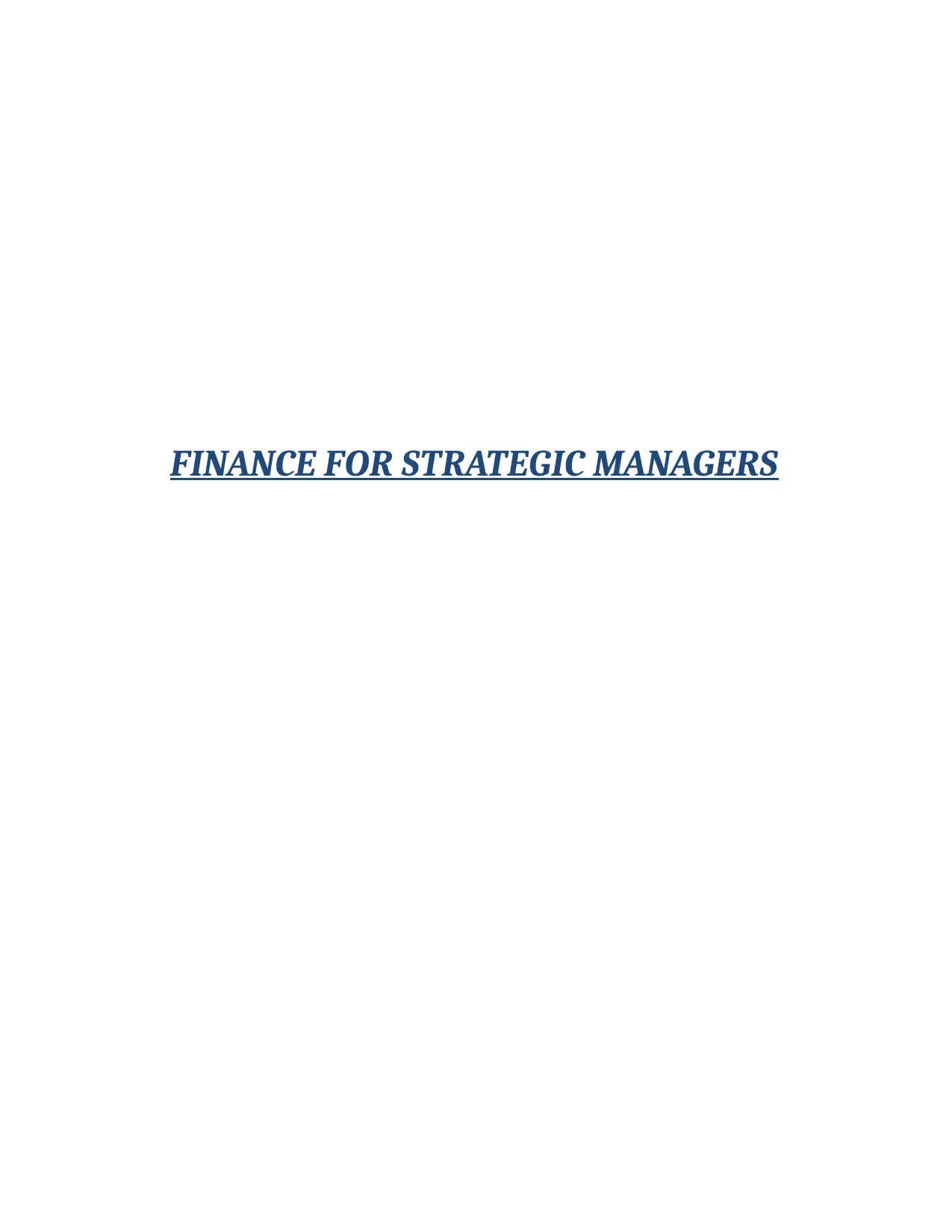
FINANCE FOR STRATEGIC MANAGERS
Paraphrase This Document
Need a fresh take? Get an instant paraphrase of this document with our AI Paraphraser
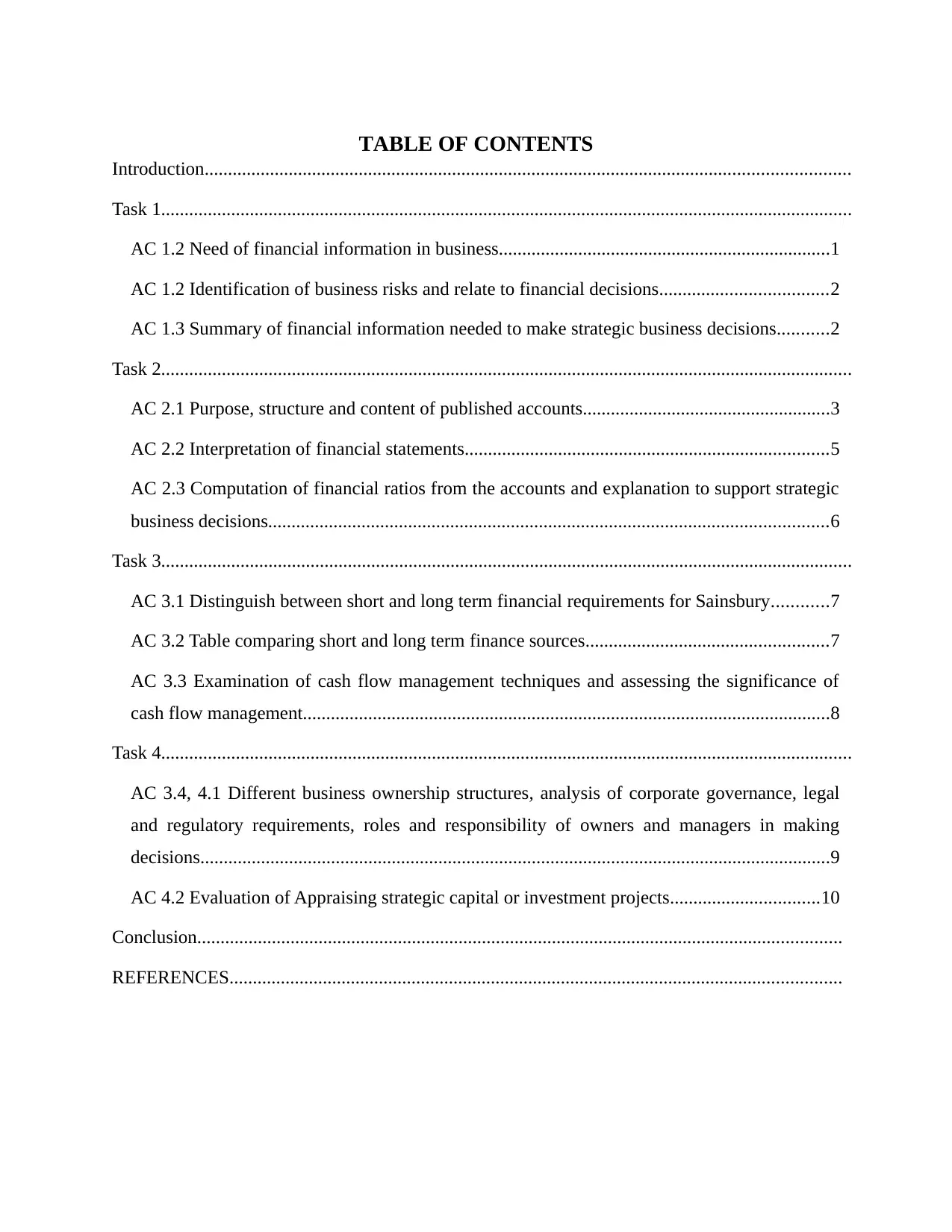
TABLE OF CONTENTS
Introduction..........................................................................................................................................
Task 1....................................................................................................................................................
AC 1.2 Need of financial information in business.......................................................................1
AC 1.2 Identification of business risks and relate to financial decisions....................................2
AC 1.3 Summary of financial information needed to make strategic business decisions...........2
Task 2....................................................................................................................................................
AC 2.1 Purpose, structure and content of published accounts.....................................................3
AC 2.2 Interpretation of financial statements..............................................................................5
AC 2.3 Computation of financial ratios from the accounts and explanation to support strategic
business decisions........................................................................................................................6
Task 3....................................................................................................................................................
AC 3.1 Distinguish between short and long term financial requirements for Sainsbury............7
AC 3.2 Table comparing short and long term finance sources....................................................7
AC 3.3 Examination of cash flow management techniques and assessing the significance of
cash flow management.................................................................................................................8
Task 4....................................................................................................................................................
AC 3.4, 4.1 Different business ownership structures, analysis of corporate governance, legal
and regulatory requirements, roles and responsibility of owners and managers in making
decisions.......................................................................................................................................9
AC 4.2 Evaluation of Appraising strategic capital or investment projects................................10
Conclusion..........................................................................................................................................
REFERENCES...................................................................................................................................
Introduction..........................................................................................................................................
Task 1....................................................................................................................................................
AC 1.2 Need of financial information in business.......................................................................1
AC 1.2 Identification of business risks and relate to financial decisions....................................2
AC 1.3 Summary of financial information needed to make strategic business decisions...........2
Task 2....................................................................................................................................................
AC 2.1 Purpose, structure and content of published accounts.....................................................3
AC 2.2 Interpretation of financial statements..............................................................................5
AC 2.3 Computation of financial ratios from the accounts and explanation to support strategic
business decisions........................................................................................................................6
Task 3....................................................................................................................................................
AC 3.1 Distinguish between short and long term financial requirements for Sainsbury............7
AC 3.2 Table comparing short and long term finance sources....................................................7
AC 3.3 Examination of cash flow management techniques and assessing the significance of
cash flow management.................................................................................................................8
Task 4....................................................................................................................................................
AC 3.4, 4.1 Different business ownership structures, analysis of corporate governance, legal
and regulatory requirements, roles and responsibility of owners and managers in making
decisions.......................................................................................................................................9
AC 4.2 Evaluation of Appraising strategic capital or investment projects................................10
Conclusion..........................................................................................................................................
REFERENCES...................................................................................................................................

LIST OF FIGURES
Figure 1: Income statement.............................................................................................................4
Figure 2: Balance sheet....................................................................................................................5
Figure 1: Income statement.............................................................................................................4
Figure 2: Balance sheet....................................................................................................................5
⊘ This is a preview!⊘
Do you want full access?
Subscribe today to unlock all pages.

Trusted by 1+ million students worldwide

INTRODUCTION
Finance is considered as the major prospect of an organisation as it is required at each
and every stage. Irrespective to the level of business it is essential for the firm to manage is funds
in effective and efficient manner so that smooth functioning can be driven. However, it is the
duty of finance managers of the firm to raise the funds and make optimum utilisation of it to
generate desired results (Bonham, 2008). Further, managerial level people are responsible for
assessing and interpreting the financial business information and taking strategic decisions to
achieve long term success. In the present report, researcher emphasis on evaluating the
significance of financial management for accomplishing business targets. In addition to this,
report illustrates need of financial data, its analysis for better judgement. Report entails
illustration of short and long term financial sources and their implications. Lastly, for making
smart investment decisions report incorporate different techniques for the support of managers.
TASK 1
AC 1.2 Need of financial information in business
Looking at the present corporate environment it is important for every organisation to
make adequate use of their available resources so as to generate desired results and outcomes.
Herein, managers play significant role by collecting financial information from the prepared
accounts and allocate and use resources. By the means of this, they are able to make effective
and smart decisions for the future contingency (Bull, 2007). Financial statements of business
highlights firm’s expenditures, revenues, operational performance, assets liabilities and owner’s
equity so that managers can assess the status of business and accordingly makes decision
regarding future contingency.
The main purpose of managers assessing the wide range of information is to employ
methods of minimizing the costs and maximize the modes of revenues so that firm can attain
long term sustainability. In this regard, managers are accountable to make in-depth analysis of
prepared financial statements so that the best possible judgement can be made to enhance firm’s
sales volume and costs and expenditures can be controlled. There are several techniques that
manager undertake i.e. comparative financial statements, ratio analysis, capital budgeting
techniques to assess the business proposals and make smart decisions. However, they are also
responsible for maintaining the liquidity and solvency position of business so as to overcome
short and long term financial obligations (Krzysko and Marciniak, 2001). Along with this, cash
1
Finance is considered as the major prospect of an organisation as it is required at each
and every stage. Irrespective to the level of business it is essential for the firm to manage is funds
in effective and efficient manner so that smooth functioning can be driven. However, it is the
duty of finance managers of the firm to raise the funds and make optimum utilisation of it to
generate desired results (Bonham, 2008). Further, managerial level people are responsible for
assessing and interpreting the financial business information and taking strategic decisions to
achieve long term success. In the present report, researcher emphasis on evaluating the
significance of financial management for accomplishing business targets. In addition to this,
report illustrates need of financial data, its analysis for better judgement. Report entails
illustration of short and long term financial sources and their implications. Lastly, for making
smart investment decisions report incorporate different techniques for the support of managers.
TASK 1
AC 1.2 Need of financial information in business
Looking at the present corporate environment it is important for every organisation to
make adequate use of their available resources so as to generate desired results and outcomes.
Herein, managers play significant role by collecting financial information from the prepared
accounts and allocate and use resources. By the means of this, they are able to make effective
and smart decisions for the future contingency (Bull, 2007). Financial statements of business
highlights firm’s expenditures, revenues, operational performance, assets liabilities and owner’s
equity so that managers can assess the status of business and accordingly makes decision
regarding future contingency.
The main purpose of managers assessing the wide range of information is to employ
methods of minimizing the costs and maximize the modes of revenues so that firm can attain
long term sustainability. In this regard, managers are accountable to make in-depth analysis of
prepared financial statements so that the best possible judgement can be made to enhance firm’s
sales volume and costs and expenditures can be controlled. There are several techniques that
manager undertake i.e. comparative financial statements, ratio analysis, capital budgeting
techniques to assess the business proposals and make smart decisions. However, they are also
responsible for maintaining the liquidity and solvency position of business so as to overcome
short and long term financial obligations (Krzysko and Marciniak, 2001). Along with this, cash
1
Paraphrase This Document
Need a fresh take? Get an instant paraphrase of this document with our AI Paraphraser

flow helps managers in understanding inflow and outflow of cash and its sources. On the basis of
this, it can be said that accurate and reliable financial information helps the course of managers
in making suitable and reliable decisions regarding future contingency.
AC 1.2 Identification of business risks and relate to financial decisions
In general, risks associated with finance is defined as the uncertainties relating to the
financial operations of business enterprise. However, it is concerned with the ability of firms in
generating funds to overcome financial commitments (Ajupov, Kurilova and Kovalenko, 2015).
In case of bank loan, every party is liable to fixed amount of interest on monthly basis therefore,
managers have to duty to maintain cash earning capacity of business so that short term economic
needs can be addressed. In addition to this, they are accountable for managing company’s interest
bearing capacity to make them capable for additional borrowings.
However, financial risk may hinder the overall functioning of business or even may leads
to the situation of bankruptcy for the firm. In this, increasing rate of interest, excess level of
debts and constantly changing foreign exchange will cause high finance cost to the firm. This is
because of the fact that, increasing rate of interest will enhance the operational liability of
business and may require high cash balance on monthly basis. Further, increase in debt amount
may obstruct the overall capital structure of business (Álvarez Nogal and Chamley, 2015).
Lastly, increasing foreign exchange rate will lead to require more cash and leads to delay in
repayment of debts.
AC 1.3 Summary of financial information needed to make strategic business decisions
In general, financial accounting can be defined as the process of recording, classifying,
summarizing and interpreting company’s financial information in suitable and reliable manner.
The main purpose of preparing financial statements is to record all the transaction relating to
business activity taken place during the reporting period. Following are the financial statements
and its information for making strategic business decisions: Profit and loss account: The main purpose of preparing this statement is that it helps in
summarizing all the revenues and expenditure that have been incurred during the
financial period (Srinivasan, 2012). It helps managers in making effective and smart
policies regarding enhancing firm’s earnings as well as reducing or controlling the
expenditure for attainment of high profits in near future.
2
this, it can be said that accurate and reliable financial information helps the course of managers
in making suitable and reliable decisions regarding future contingency.
AC 1.2 Identification of business risks and relate to financial decisions
In general, risks associated with finance is defined as the uncertainties relating to the
financial operations of business enterprise. However, it is concerned with the ability of firms in
generating funds to overcome financial commitments (Ajupov, Kurilova and Kovalenko, 2015).
In case of bank loan, every party is liable to fixed amount of interest on monthly basis therefore,
managers have to duty to maintain cash earning capacity of business so that short term economic
needs can be addressed. In addition to this, they are accountable for managing company’s interest
bearing capacity to make them capable for additional borrowings.
However, financial risk may hinder the overall functioning of business or even may leads
to the situation of bankruptcy for the firm. In this, increasing rate of interest, excess level of
debts and constantly changing foreign exchange will cause high finance cost to the firm. This is
because of the fact that, increasing rate of interest will enhance the operational liability of
business and may require high cash balance on monthly basis. Further, increase in debt amount
may obstruct the overall capital structure of business (Álvarez Nogal and Chamley, 2015).
Lastly, increasing foreign exchange rate will lead to require more cash and leads to delay in
repayment of debts.
AC 1.3 Summary of financial information needed to make strategic business decisions
In general, financial accounting can be defined as the process of recording, classifying,
summarizing and interpreting company’s financial information in suitable and reliable manner.
The main purpose of preparing financial statements is to record all the transaction relating to
business activity taken place during the reporting period. Following are the financial statements
and its information for making strategic business decisions: Profit and loss account: The main purpose of preparing this statement is that it helps in
summarizing all the revenues and expenditure that have been incurred during the
financial period (Srinivasan, 2012). It helps managers in making effective and smart
policies regarding enhancing firm’s earnings as well as reducing or controlling the
expenditure for attainment of high profits in near future.
2

Balance sheet: It showcase the financial position of business enterprise which is based
on an equation i.e. Assets = Liabilities + Equity Capital. It is duty of managers to make
optimum utilisation of assets to generate higher profits. On the other hand, liabilities of
business indicates the obligations that company has to pay to its outsiders. Whereas,
equity is the proportion of owner’s funds to total company’s assets (Weaver and Weson,
2007). By the means of this statement, managers establish appropriate working capital
management, solvency position and enhance managerial efficiency to use company’s
assets.
Cash flow statement: It illustrates the inflow and outflow of cash from the means of
operating, financing and investing activities. Through the means of this statement
managerial level people ensures adequate cash balance for mitigating short and long
term financial needs.
TASK 2
AC 2.1 Purpose, structure and content of published accounts
For the purpose of understanding purpose, structure and content of published accounts,
Sainsbury has been undertake. Herein, financial statements of cited firm has been highlighted to
enhance the understanding of learners and readers. Operating at such a large level it is important
for top level management of Sainsbury to prepare major financial statements so that they can
record and showcase vital and accurate information to stakeholders (Elbannan and Elbannan,
2015). Herein, the main purpose of Sainsbury in preparing profit and loss account is to determine
the operational results i.e. gross profit, operating profit and net profit. Further, balance sheet is
prepared with the aim of determining the actual financial position of business (Sainsbury's
Annual report, 2015). Following are the published statements of Sainsbury:
3
on an equation i.e. Assets = Liabilities + Equity Capital. It is duty of managers to make
optimum utilisation of assets to generate higher profits. On the other hand, liabilities of
business indicates the obligations that company has to pay to its outsiders. Whereas,
equity is the proportion of owner’s funds to total company’s assets (Weaver and Weson,
2007). By the means of this statement, managers establish appropriate working capital
management, solvency position and enhance managerial efficiency to use company’s
assets.
Cash flow statement: It illustrates the inflow and outflow of cash from the means of
operating, financing and investing activities. Through the means of this statement
managerial level people ensures adequate cash balance for mitigating short and long
term financial needs.
TASK 2
AC 2.1 Purpose, structure and content of published accounts
For the purpose of understanding purpose, structure and content of published accounts,
Sainsbury has been undertake. Herein, financial statements of cited firm has been highlighted to
enhance the understanding of learners and readers. Operating at such a large level it is important
for top level management of Sainsbury to prepare major financial statements so that they can
record and showcase vital and accurate information to stakeholders (Elbannan and Elbannan,
2015). Herein, the main purpose of Sainsbury in preparing profit and loss account is to determine
the operational results i.e. gross profit, operating profit and net profit. Further, balance sheet is
prepared with the aim of determining the actual financial position of business (Sainsbury's
Annual report, 2015). Following are the published statements of Sainsbury:
3
⊘ This is a preview!⊘
Do you want full access?
Subscribe today to unlock all pages.

Trusted by 1+ million students worldwide
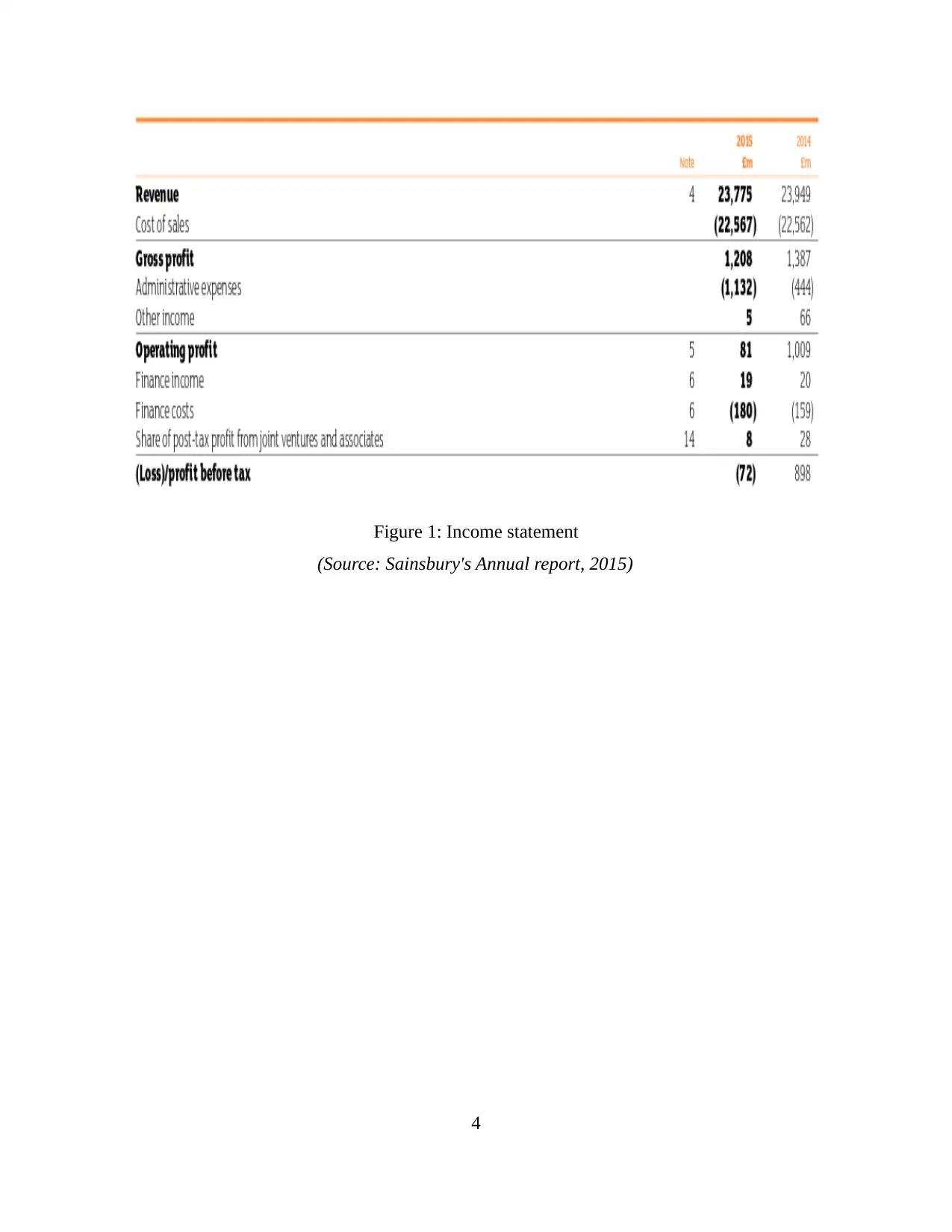
Figure 1: Income statement
(Source: Sainsbury's Annual report, 2015)
4
(Source: Sainsbury's Annual report, 2015)
4
Paraphrase This Document
Need a fresh take? Get an instant paraphrase of this document with our AI Paraphraser

Figure 2: Balance sheet
(Source: Sainsbury's Annual report, 2015)
AC 2.2 Interpretation of financial statements
From the above depicted financial statements, Sainsbury’s actual position can be
evaluated. However, the results clearly indicates that in 2015 cited firm is unable to perform to
its potential. It is because of the fact that, profitability of firm has declined significantly because
of the increasing loss from its operations (Giovannini and et.al., 2015). This signify the poor and
weak operational performance of Sainsbury as compared to competitors and industry averages.
5
(Source: Sainsbury's Annual report, 2015)
AC 2.2 Interpretation of financial statements
From the above depicted financial statements, Sainsbury’s actual position can be
evaluated. However, the results clearly indicates that in 2015 cited firm is unable to perform to
its potential. It is because of the fact that, profitability of firm has declined significantly because
of the increasing loss from its operations (Giovannini and et.al., 2015). This signify the poor and
weak operational performance of Sainsbury as compared to competitors and industry averages.
5
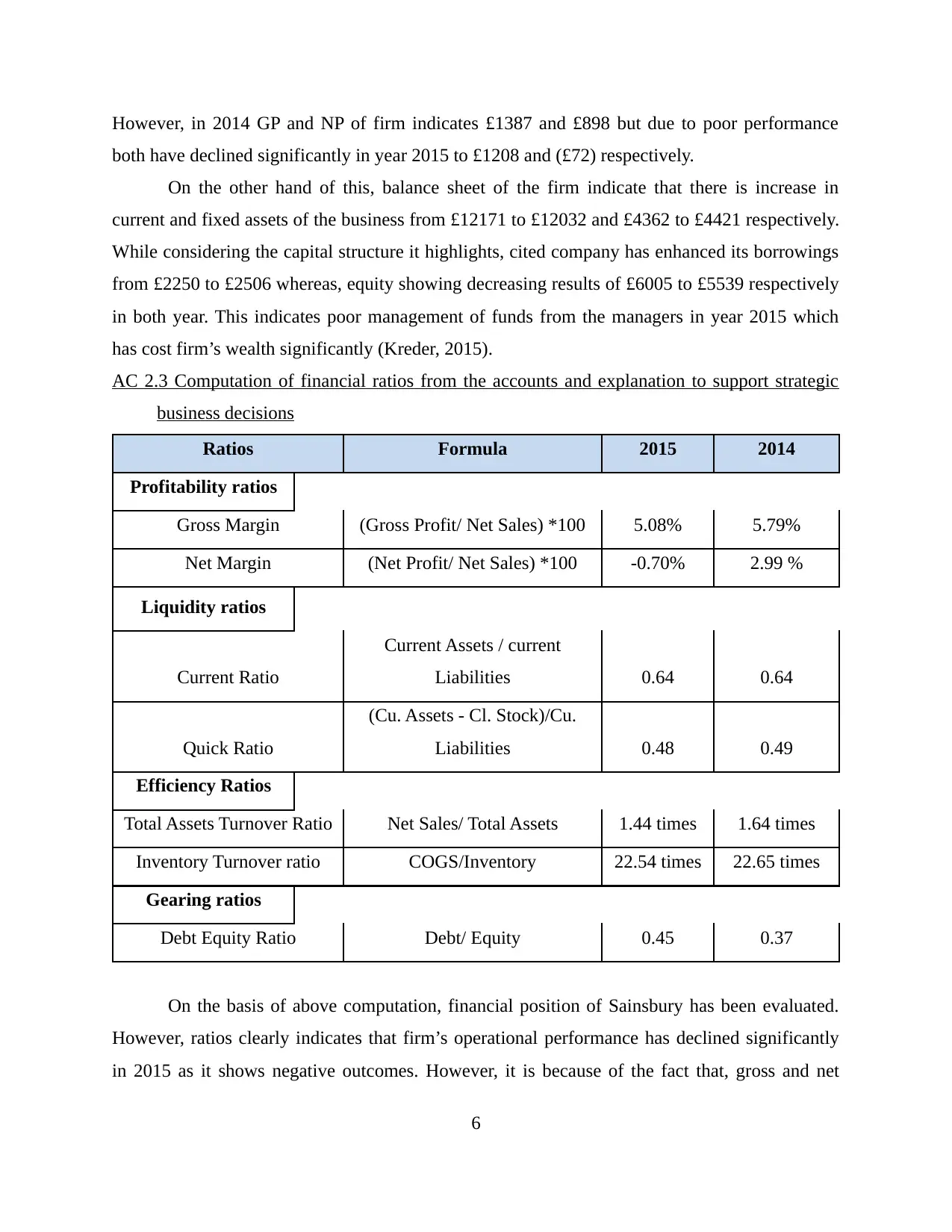
However, in 2014 GP and NP of firm indicates £1387 and £898 but due to poor performance
both have declined significantly in year 2015 to £1208 and (£72) respectively.
On the other hand of this, balance sheet of the firm indicate that there is increase in
current and fixed assets of the business from £12171 to £12032 and £4362 to £4421 respectively.
While considering the capital structure it highlights, cited company has enhanced its borrowings
from £2250 to £2506 whereas, equity showing decreasing results of £6005 to £5539 respectively
in both year. This indicates poor management of funds from the managers in year 2015 which
has cost firm’s wealth significantly (Kreder, 2015).
AC 2.3 Computation of financial ratios from the accounts and explanation to support strategic
business decisions
Ratios Formula 2015 2014
Profitability ratios
Gross Margin (Gross Profit/ Net Sales) *100 5.08% 5.79%
Net Margin (Net Profit/ Net Sales) *100 -0.70% 2.99 %
Liquidity ratios
Current Ratio
Current Assets / current
Liabilities 0.64 0.64
Quick Ratio
(Cu. Assets - Cl. Stock)/Cu.
Liabilities 0.48 0.49
Efficiency Ratios
Total Assets Turnover Ratio Net Sales/ Total Assets 1.44 times 1.64 times
Inventory Turnover ratio COGS/Inventory 22.54 times 22.65 times
Gearing ratios
Debt Equity Ratio Debt/ Equity 0.45 0.37
On the basis of above computation, financial position of Sainsbury has been evaluated.
However, ratios clearly indicates that firm’s operational performance has declined significantly
in 2015 as it shows negative outcomes. However, it is because of the fact that, gross and net
6
both have declined significantly in year 2015 to £1208 and (£72) respectively.
On the other hand of this, balance sheet of the firm indicate that there is increase in
current and fixed assets of the business from £12171 to £12032 and £4362 to £4421 respectively.
While considering the capital structure it highlights, cited company has enhanced its borrowings
from £2250 to £2506 whereas, equity showing decreasing results of £6005 to £5539 respectively
in both year. This indicates poor management of funds from the managers in year 2015 which
has cost firm’s wealth significantly (Kreder, 2015).
AC 2.3 Computation of financial ratios from the accounts and explanation to support strategic
business decisions
Ratios Formula 2015 2014
Profitability ratios
Gross Margin (Gross Profit/ Net Sales) *100 5.08% 5.79%
Net Margin (Net Profit/ Net Sales) *100 -0.70% 2.99 %
Liquidity ratios
Current Ratio
Current Assets / current
Liabilities 0.64 0.64
Quick Ratio
(Cu. Assets - Cl. Stock)/Cu.
Liabilities 0.48 0.49
Efficiency Ratios
Total Assets Turnover Ratio Net Sales/ Total Assets 1.44 times 1.64 times
Inventory Turnover ratio COGS/Inventory 22.54 times 22.65 times
Gearing ratios
Debt Equity Ratio Debt/ Equity 0.45 0.37
On the basis of above computation, financial position of Sainsbury has been evaluated.
However, ratios clearly indicates that firm’s operational performance has declined significantly
in 2015 as it shows negative outcomes. However, it is because of the fact that, gross and net
6
⊘ This is a preview!⊘
Do you want full access?
Subscribe today to unlock all pages.

Trusted by 1+ million students worldwide

margin of the company is poor results of 5.08% and -0.70% as compared to lasts year
performance. Further, liquidity position of showing stable outcomes which signify the potential
capability of firm in meeting its short term financial obligations (Kreder, 2015). Contradicting to
this, turnover ratio clearly indicates that managers are unable to make optimum use of assets and
inventory to generate desired revenue as compared to previous year ratio i.e. in 2014 1.64 and
22.65 times to 1.44 and 22.54 times respectively in 2015. Along with this increase in debt to
equity ratio of 0.45 indicates that there managers has used debt financing to raise funds as
compared to sources of equity financing. But comparing it to industry standards of 0.5:1 the
generated results are acceptable for the firm which indicates the sources used are on the basis of
proper assessment (Götze, Northcott and Schuster, 2015). Considering other prospects it is
important for the management of Sainsbury to formulate competent strategies so as to enhance
the level of business performance and generate the best possible outcomes.
TASK 3
AC 3.1 Distinguish between short and long term financial requirements for Sainsbury
Finance as stated above is the integral part of an organisation as it is required at every
level of the functioning. Thus, need of finance arises in every type of businesses. However, there
are two kinds financial requirement i.e. short and long term. In general, short term finance is
required for running operational activities of business. The main purpose of these funds is to
carry out day to day operations of Sainsbury effectively (Weygandt and et. al., 2009). Herein,
Sainsbury has to purchase raw materials, pay wages, salaries, rent, advertisement expenditure,
insurance, postage, stationary charges etc. In order to carry out each prospects appropriately,
management need to raise adequate amount of fund from short term financing. On the other hand
of it, long term financing is required by Sainsbury to purchase fixed assets such as plant and
machinery, property, equipment and building etc. By the means of these Sainsbury aims to raise
profits on long term basis. Operating at such a large level it important for the cited firm to
maintain proper balance between short and long term financing needs as they will lead to expand
business operations and increases long term sustainability.
AC 3.2 Table comparing short and long term finance sources
There are different short and long term financial sources that are available for the
management of Sainsbury in order to overcome financial needs and wants:
Short term finance sources:
7
performance. Further, liquidity position of showing stable outcomes which signify the potential
capability of firm in meeting its short term financial obligations (Kreder, 2015). Contradicting to
this, turnover ratio clearly indicates that managers are unable to make optimum use of assets and
inventory to generate desired revenue as compared to previous year ratio i.e. in 2014 1.64 and
22.65 times to 1.44 and 22.54 times respectively in 2015. Along with this increase in debt to
equity ratio of 0.45 indicates that there managers has used debt financing to raise funds as
compared to sources of equity financing. But comparing it to industry standards of 0.5:1 the
generated results are acceptable for the firm which indicates the sources used are on the basis of
proper assessment (Götze, Northcott and Schuster, 2015). Considering other prospects it is
important for the management of Sainsbury to formulate competent strategies so as to enhance
the level of business performance and generate the best possible outcomes.
TASK 3
AC 3.1 Distinguish between short and long term financial requirements for Sainsbury
Finance as stated above is the integral part of an organisation as it is required at every
level of the functioning. Thus, need of finance arises in every type of businesses. However, there
are two kinds financial requirement i.e. short and long term. In general, short term finance is
required for running operational activities of business. The main purpose of these funds is to
carry out day to day operations of Sainsbury effectively (Weygandt and et. al., 2009). Herein,
Sainsbury has to purchase raw materials, pay wages, salaries, rent, advertisement expenditure,
insurance, postage, stationary charges etc. In order to carry out each prospects appropriately,
management need to raise adequate amount of fund from short term financing. On the other hand
of it, long term financing is required by Sainsbury to purchase fixed assets such as plant and
machinery, property, equipment and building etc. By the means of these Sainsbury aims to raise
profits on long term basis. Operating at such a large level it important for the cited firm to
maintain proper balance between short and long term financing needs as they will lead to expand
business operations and increases long term sustainability.
AC 3.2 Table comparing short and long term finance sources
There are different short and long term financial sources that are available for the
management of Sainsbury in order to overcome financial needs and wants:
Short term finance sources:
7
Paraphrase This Document
Need a fresh take? Get an instant paraphrase of this document with our AI Paraphraser
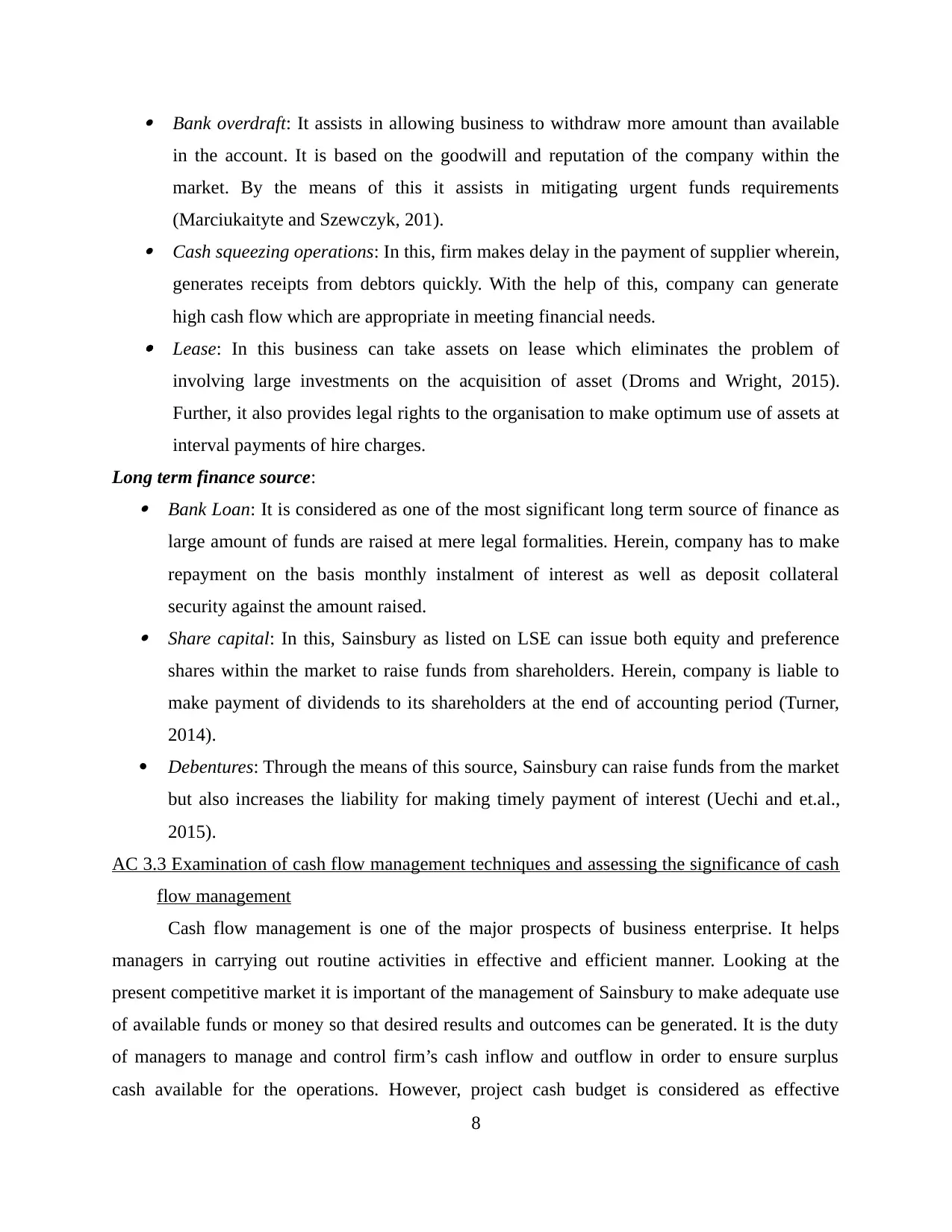
Bank overdraft: It assists in allowing business to withdraw more amount than available
in the account. It is based on the goodwill and reputation of the company within the
market. By the means of this it assists in mitigating urgent funds requirements
(Marciukaityte and Szewczyk, 201). Cash squeezing operations: In this, firm makes delay in the payment of supplier wherein,
generates receipts from debtors quickly. With the help of this, company can generate
high cash flow which are appropriate in meeting financial needs. Lease: In this business can take assets on lease which eliminates the problem of
involving large investments on the acquisition of asset (Droms and Wright, 2015).
Further, it also provides legal rights to the organisation to make optimum use of assets at
interval payments of hire charges.
Long term finance source: Bank Loan: It is considered as one of the most significant long term source of finance as
large amount of funds are raised at mere legal formalities. Herein, company has to make
repayment on the basis monthly instalment of interest as well as deposit collateral
security against the amount raised. Share capital: In this, Sainsbury as listed on LSE can issue both equity and preference
shares within the market to raise funds from shareholders. Herein, company is liable to
make payment of dividends to its shareholders at the end of accounting period (Turner,
2014).
Debentures: Through the means of this source, Sainsbury can raise funds from the market
but also increases the liability for making timely payment of interest (Uechi and et.al.,
2015).
AC 3.3 Examination of cash flow management techniques and assessing the significance of cash
flow management
Cash flow management is one of the major prospects of business enterprise. It helps
managers in carrying out routine activities in effective and efficient manner. Looking at the
present competitive market it is important of the management of Sainsbury to make adequate use
of available funds or money so that desired results and outcomes can be generated. It is the duty
of managers to manage and control firm’s cash inflow and outflow in order to ensure surplus
cash available for the operations. However, project cash budget is considered as effective
8
in the account. It is based on the goodwill and reputation of the company within the
market. By the means of this it assists in mitigating urgent funds requirements
(Marciukaityte and Szewczyk, 201). Cash squeezing operations: In this, firm makes delay in the payment of supplier wherein,
generates receipts from debtors quickly. With the help of this, company can generate
high cash flow which are appropriate in meeting financial needs. Lease: In this business can take assets on lease which eliminates the problem of
involving large investments on the acquisition of asset (Droms and Wright, 2015).
Further, it also provides legal rights to the organisation to make optimum use of assets at
interval payments of hire charges.
Long term finance source: Bank Loan: It is considered as one of the most significant long term source of finance as
large amount of funds are raised at mere legal formalities. Herein, company has to make
repayment on the basis monthly instalment of interest as well as deposit collateral
security against the amount raised. Share capital: In this, Sainsbury as listed on LSE can issue both equity and preference
shares within the market to raise funds from shareholders. Herein, company is liable to
make payment of dividends to its shareholders at the end of accounting period (Turner,
2014).
Debentures: Through the means of this source, Sainsbury can raise funds from the market
but also increases the liability for making timely payment of interest (Uechi and et.al.,
2015).
AC 3.3 Examination of cash flow management techniques and assessing the significance of cash
flow management
Cash flow management is one of the major prospects of business enterprise. It helps
managers in carrying out routine activities in effective and efficient manner. Looking at the
present competitive market it is important of the management of Sainsbury to make adequate use
of available funds or money so that desired results and outcomes can be generated. It is the duty
of managers to manage and control firm’s cash inflow and outflow in order to ensure surplus
cash available for the operations. However, project cash budget is considered as effective
8
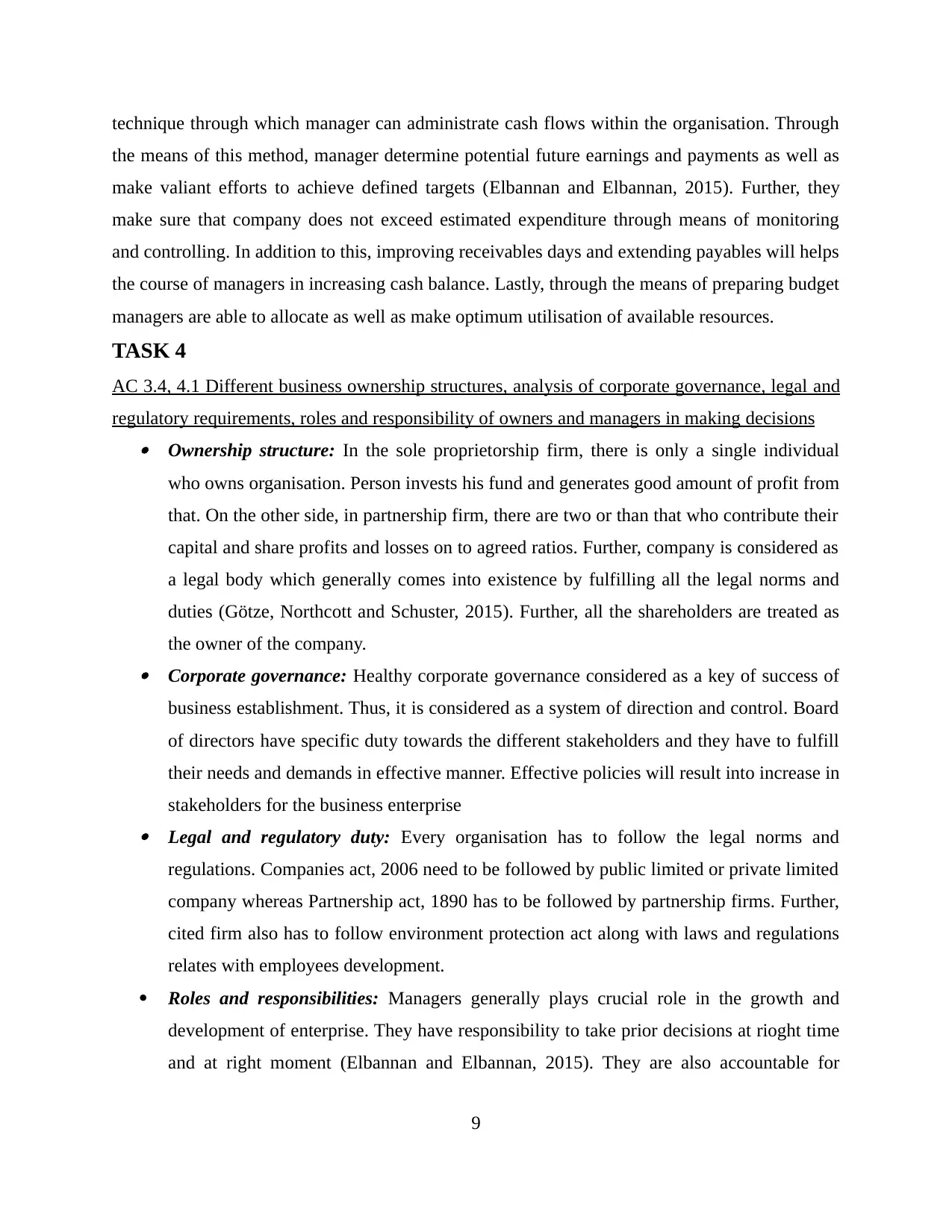
technique through which manager can administrate cash flows within the organisation. Through
the means of this method, manager determine potential future earnings and payments as well as
make valiant efforts to achieve defined targets (Elbannan and Elbannan, 2015). Further, they
make sure that company does not exceed estimated expenditure through means of monitoring
and controlling. In addition to this, improving receivables days and extending payables will helps
the course of managers in increasing cash balance. Lastly, through the means of preparing budget
managers are able to allocate as well as make optimum utilisation of available resources.
TASK 4
AC 3.4, 4.1 Different business ownership structures, analysis of corporate governance, legal and
regulatory requirements, roles and responsibility of owners and managers in making decisions Ownership structure: In the sole proprietorship firm, there is only a single individual
who owns organisation. Person invests his fund and generates good amount of profit from
that. On the other side, in partnership firm, there are two or than that who contribute their
capital and share profits and losses on to agreed ratios. Further, company is considered as
a legal body which generally comes into existence by fulfilling all the legal norms and
duties (Götze, Northcott and Schuster, 2015). Further, all the shareholders are treated as
the owner of the company. Corporate governance: Healthy corporate governance considered as a key of success of
business establishment. Thus, it is considered as a system of direction and control. Board
of directors have specific duty towards the different stakeholders and they have to fulfill
their needs and demands in effective manner. Effective policies will result into increase in
stakeholders for the business enterprise Legal and regulatory duty: Every organisation has to follow the legal norms and
regulations. Companies act, 2006 need to be followed by public limited or private limited
company whereas Partnership act, 1890 has to be followed by partnership firms. Further,
cited firm also has to follow environment protection act along with laws and regulations
relates with employees development.
Roles and responsibilities: Managers generally plays crucial role in the growth and
development of enterprise. They have responsibility to take prior decisions at rioght time
and at right moment (Elbannan and Elbannan, 2015). They are also accountable for
9
the means of this method, manager determine potential future earnings and payments as well as
make valiant efforts to achieve defined targets (Elbannan and Elbannan, 2015). Further, they
make sure that company does not exceed estimated expenditure through means of monitoring
and controlling. In addition to this, improving receivables days and extending payables will helps
the course of managers in increasing cash balance. Lastly, through the means of preparing budget
managers are able to allocate as well as make optimum utilisation of available resources.
TASK 4
AC 3.4, 4.1 Different business ownership structures, analysis of corporate governance, legal and
regulatory requirements, roles and responsibility of owners and managers in making decisions Ownership structure: In the sole proprietorship firm, there is only a single individual
who owns organisation. Person invests his fund and generates good amount of profit from
that. On the other side, in partnership firm, there are two or than that who contribute their
capital and share profits and losses on to agreed ratios. Further, company is considered as
a legal body which generally comes into existence by fulfilling all the legal norms and
duties (Götze, Northcott and Schuster, 2015). Further, all the shareholders are treated as
the owner of the company. Corporate governance: Healthy corporate governance considered as a key of success of
business establishment. Thus, it is considered as a system of direction and control. Board
of directors have specific duty towards the different stakeholders and they have to fulfill
their needs and demands in effective manner. Effective policies will result into increase in
stakeholders for the business enterprise Legal and regulatory duty: Every organisation has to follow the legal norms and
regulations. Companies act, 2006 need to be followed by public limited or private limited
company whereas Partnership act, 1890 has to be followed by partnership firms. Further,
cited firm also has to follow environment protection act along with laws and regulations
relates with employees development.
Roles and responsibilities: Managers generally plays crucial role in the growth and
development of enterprise. They have responsibility to take prior decisions at rioght time
and at right moment (Elbannan and Elbannan, 2015). They are also accountable for
9
⊘ This is a preview!⊘
Do you want full access?
Subscribe today to unlock all pages.

Trusted by 1+ million students worldwide
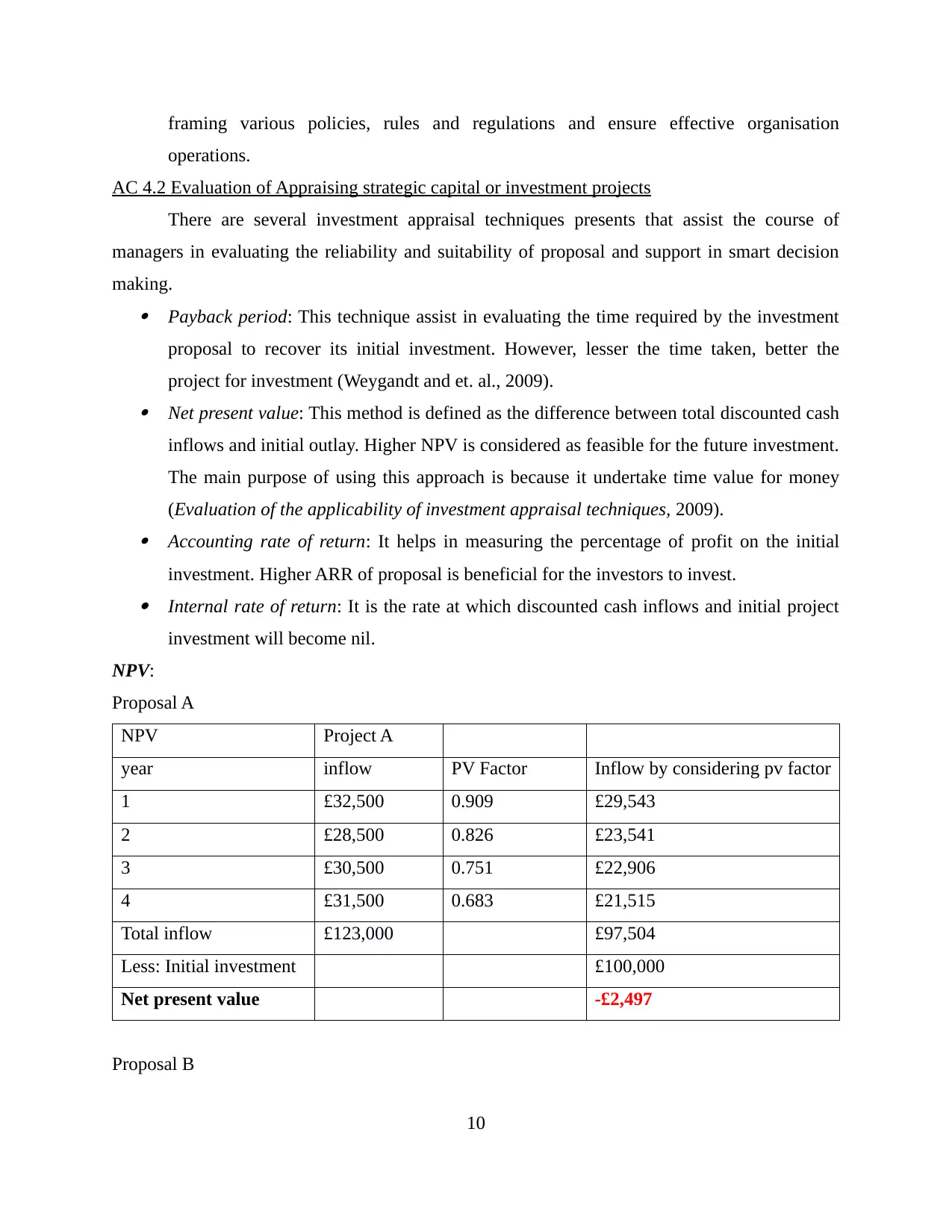
framing various policies, rules and regulations and ensure effective organisation
operations.
AC 4.2 Evaluation of Appraising strategic capital or investment projects
There are several investment appraisal techniques presents that assist the course of
managers in evaluating the reliability and suitability of proposal and support in smart decision
making. Payback period: This technique assist in evaluating the time required by the investment
proposal to recover its initial investment. However, lesser the time taken, better the
project for investment (Weygandt and et. al., 2009). Net present value: This method is defined as the difference between total discounted cash
inflows and initial outlay. Higher NPV is considered as feasible for the future investment.
The main purpose of using this approach is because it undertake time value for money
(Evaluation of the applicability of investment appraisal techniques, 2009). Accounting rate of return: It helps in measuring the percentage of profit on the initial
investment. Higher ARR of proposal is beneficial for the investors to invest. Internal rate of return: It is the rate at which discounted cash inflows and initial project
investment will become nil.
NPV:
Proposal A
NPV Project A
year inflow PV Factor Inflow by considering pv factor
1 £32,500 0.909 £29,543
2 £28,500 0.826 £23,541
3 £30,500 0.751 £22,906
4 £31,500 0.683 £21,515
Total inflow £123,000 £97,504
Less: Initial investment £100,000
Net present value -£2,497
Proposal B
10
operations.
AC 4.2 Evaluation of Appraising strategic capital or investment projects
There are several investment appraisal techniques presents that assist the course of
managers in evaluating the reliability and suitability of proposal and support in smart decision
making. Payback period: This technique assist in evaluating the time required by the investment
proposal to recover its initial investment. However, lesser the time taken, better the
project for investment (Weygandt and et. al., 2009). Net present value: This method is defined as the difference between total discounted cash
inflows and initial outlay. Higher NPV is considered as feasible for the future investment.
The main purpose of using this approach is because it undertake time value for money
(Evaluation of the applicability of investment appraisal techniques, 2009). Accounting rate of return: It helps in measuring the percentage of profit on the initial
investment. Higher ARR of proposal is beneficial for the investors to invest. Internal rate of return: It is the rate at which discounted cash inflows and initial project
investment will become nil.
NPV:
Proposal A
NPV Project A
year inflow PV Factor Inflow by considering pv factor
1 £32,500 0.909 £29,543
2 £28,500 0.826 £23,541
3 £30,500 0.751 £22,906
4 £31,500 0.683 £21,515
Total inflow £123,000 £97,504
Less: Initial investment £100,000
Net present value -£2,497
Proposal B
10
Paraphrase This Document
Need a fresh take? Get an instant paraphrase of this document with our AI Paraphraser
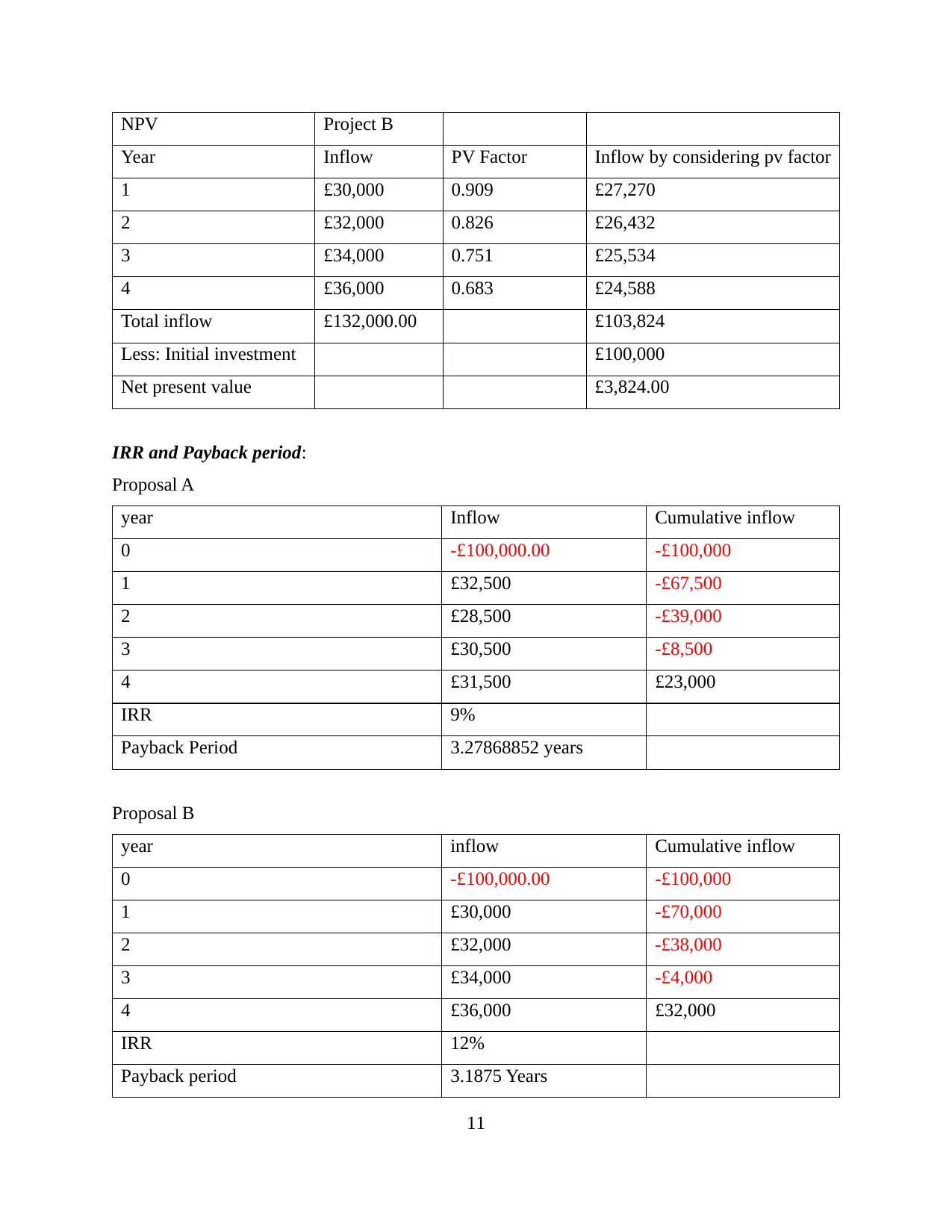
NPV Project B
Year Inflow PV Factor Inflow by considering pv factor
1 £30,000 0.909 £27,270
2 £32,000 0.826 £26,432
3 £34,000 0.751 £25,534
4 £36,000 0.683 £24,588
Total inflow £132,000.00 £103,824
Less: Initial investment £100,000
Net present value £3,824.00
IRR and Payback period:
Proposal A
year Inflow Cumulative inflow
0 -£100,000.00 -£100,000
1 £32,500 -£67,500
2 £28,500 -£39,000
3 £30,500 -£8,500
4 £31,500 £23,000
IRR 9%
Payback Period 3.27868852 years
Proposal B
year inflow Cumulative inflow
0 -£100,000.00 -£100,000
1 £30,000 -£70,000
2 £32,000 -£38,000
3 £34,000 -£4,000
4 £36,000 £32,000
IRR 12%
Payback period 3.1875 Years
11
Year Inflow PV Factor Inflow by considering pv factor
1 £30,000 0.909 £27,270
2 £32,000 0.826 £26,432
3 £34,000 0.751 £25,534
4 £36,000 0.683 £24,588
Total inflow £132,000.00 £103,824
Less: Initial investment £100,000
Net present value £3,824.00
IRR and Payback period:
Proposal A
year Inflow Cumulative inflow
0 -£100,000.00 -£100,000
1 £32,500 -£67,500
2 £28,500 -£39,000
3 £30,500 -£8,500
4 £31,500 £23,000
IRR 9%
Payback Period 3.27868852 years
Proposal B
year inflow Cumulative inflow
0 -£100,000.00 -£100,000
1 £30,000 -£70,000
2 £32,000 -£38,000
3 £34,000 -£4,000
4 £36,000 £32,000
IRR 12%
Payback period 3.1875 Years
11
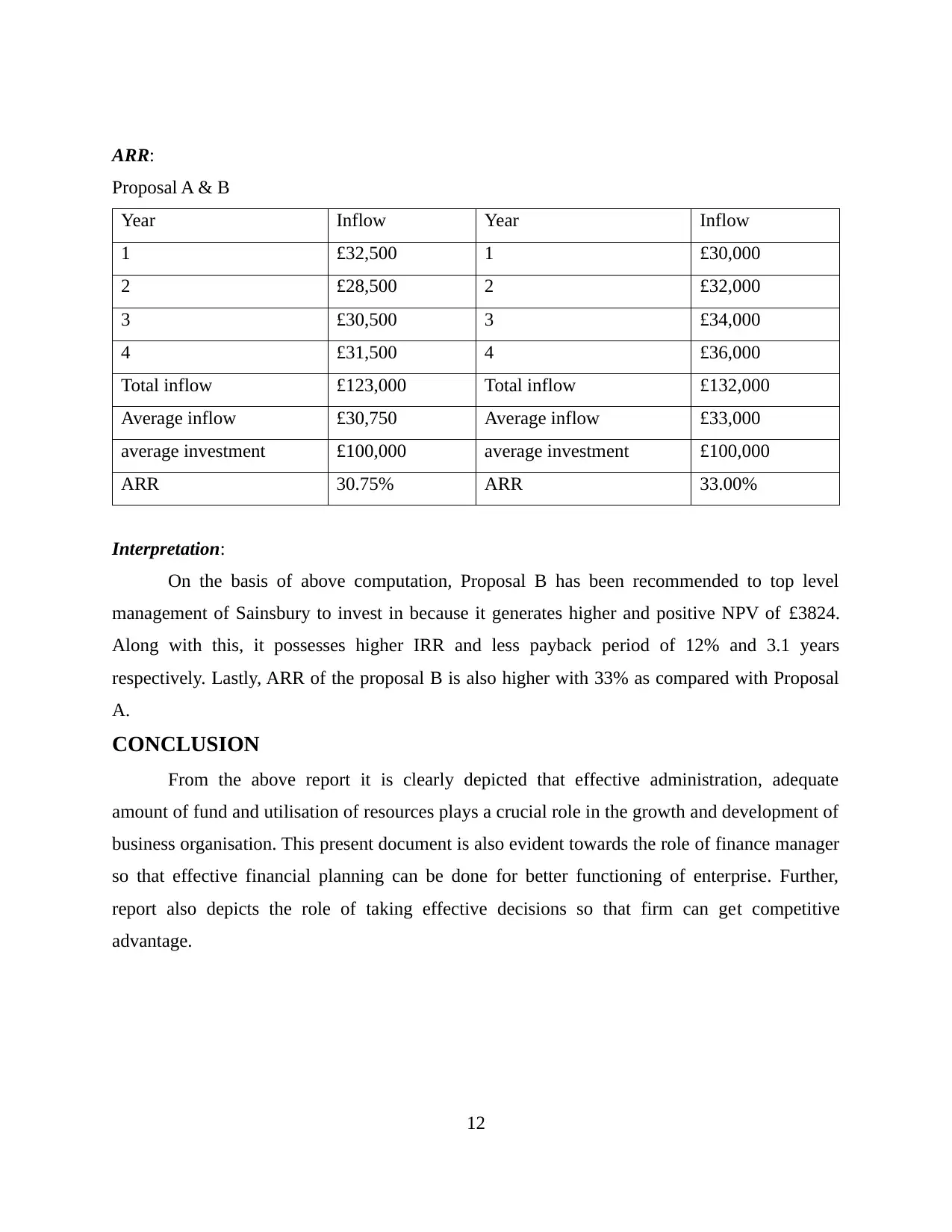
ARR:
Proposal A & B
Year Inflow Year Inflow
1 £32,500 1 £30,000
2 £28,500 2 £32,000
3 £30,500 3 £34,000
4 £31,500 4 £36,000
Total inflow £123,000 Total inflow £132,000
Average inflow £30,750 Average inflow £33,000
average investment £100,000 average investment £100,000
ARR 30.75% ARR 33.00%
Interpretation:
On the basis of above computation, Proposal B has been recommended to top level
management of Sainsbury to invest in because it generates higher and positive NPV of £3824.
Along with this, it possesses higher IRR and less payback period of 12% and 3.1 years
respectively. Lastly, ARR of the proposal B is also higher with 33% as compared with Proposal
A.
CONCLUSION
From the above report it is clearly depicted that effective administration, adequate
amount of fund and utilisation of resources plays a crucial role in the growth and development of
business organisation. This present document is also evident towards the role of finance manager
so that effective financial planning can be done for better functioning of enterprise. Further,
report also depicts the role of taking effective decisions so that firm can get competitive
advantage.
12
Proposal A & B
Year Inflow Year Inflow
1 £32,500 1 £30,000
2 £28,500 2 £32,000
3 £30,500 3 £34,000
4 £31,500 4 £36,000
Total inflow £123,000 Total inflow £132,000
Average inflow £30,750 Average inflow £33,000
average investment £100,000 average investment £100,000
ARR 30.75% ARR 33.00%
Interpretation:
On the basis of above computation, Proposal B has been recommended to top level
management of Sainsbury to invest in because it generates higher and positive NPV of £3824.
Along with this, it possesses higher IRR and less payback period of 12% and 3.1 years
respectively. Lastly, ARR of the proposal B is also higher with 33% as compared with Proposal
A.
CONCLUSION
From the above report it is clearly depicted that effective administration, adequate
amount of fund and utilisation of resources plays a crucial role in the growth and development of
business organisation. This present document is also evident towards the role of finance manager
so that effective financial planning can be done for better functioning of enterprise. Further,
report also depicts the role of taking effective decisions so that firm can get competitive
advantage.
12
⊘ This is a preview!⊘
Do you want full access?
Subscribe today to unlock all pages.

Trusted by 1+ million students worldwide
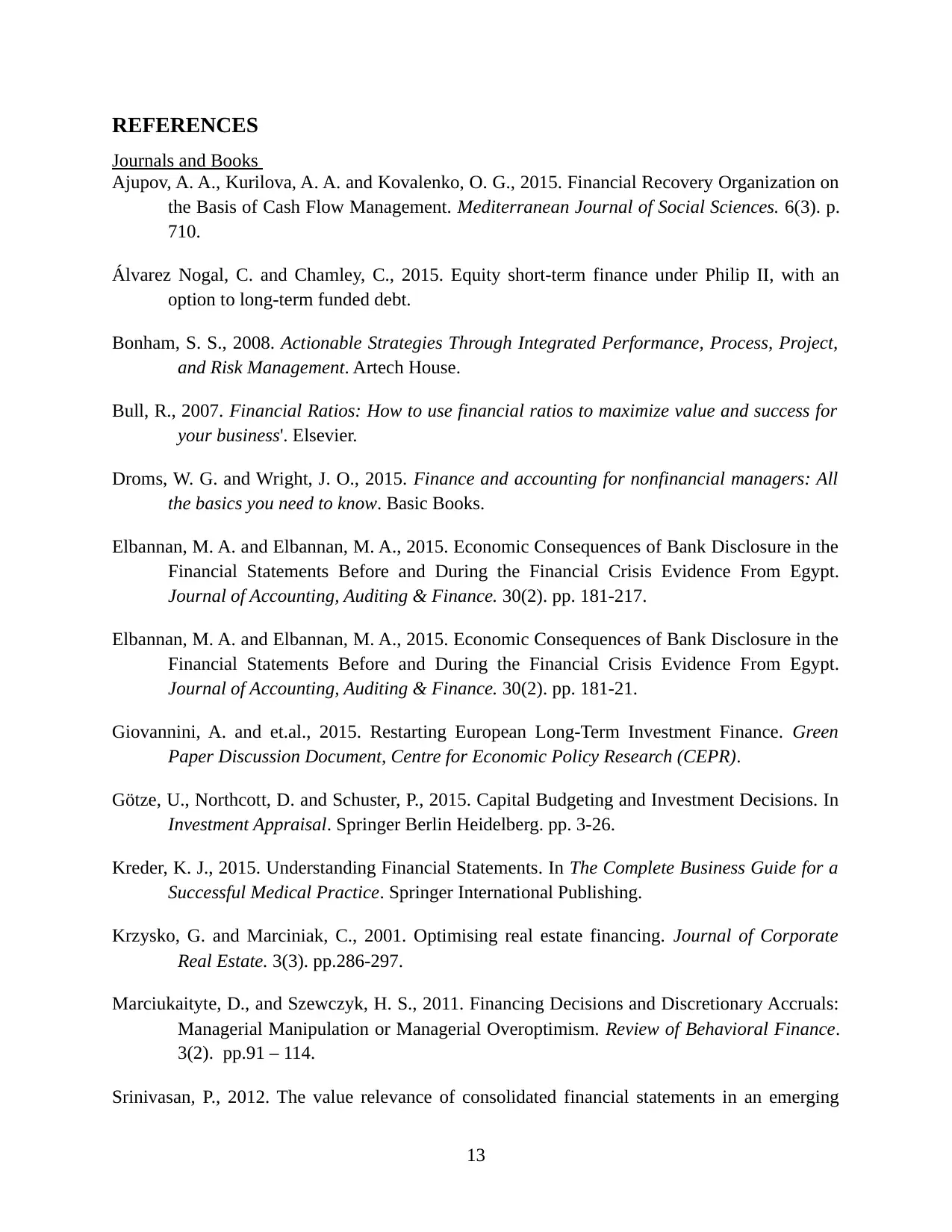
REFERENCES
Journals and Books
Ajupov, A. A., Kurilova, A. A. and Kovalenko, O. G., 2015. Financial Recovery Organization on
the Basis of Cash Flow Management. Mediterranean Journal of Social Sciences. 6(3). p.
710.
Álvarez Nogal, C. and Chamley, C., 2015. Equity short-term finance under Philip II, with an
option to long-term funded debt.
Bonham, S. S., 2008. Actionable Strategies Through Integrated Performance, Process, Project,
and Risk Management. Artech House.
Bull, R., 2007. Financial Ratios: How to use financial ratios to maximize value and success for
your business'. Elsevier.
Droms, W. G. and Wright, J. O., 2015. Finance and accounting for nonfinancial managers: All
the basics you need to know. Basic Books.
Elbannan, M. A. and Elbannan, M. A., 2015. Economic Consequences of Bank Disclosure in the
Financial Statements Before and During the Financial Crisis Evidence From Egypt.
Journal of Accounting, Auditing & Finance. 30(2). pp. 181-217.
Elbannan, M. A. and Elbannan, M. A., 2015. Economic Consequences of Bank Disclosure in the
Financial Statements Before and During the Financial Crisis Evidence From Egypt.
Journal of Accounting, Auditing & Finance. 30(2). pp. 181-21.
Giovannini, A. and et.al., 2015. Restarting European Long-Term Investment Finance. Green
Paper Discussion Document, Centre for Economic Policy Research (CEPR).
Götze, U., Northcott, D. and Schuster, P., 2015. Capital Budgeting and Investment Decisions. In
Investment Appraisal. Springer Berlin Heidelberg. pp. 3-26.
Kreder, K. J., 2015. Understanding Financial Statements. In The Complete Business Guide for a
Successful Medical Practice. Springer International Publishing.
Krzysko, G. and Marciniak, C., 2001. Optimising real estate financing. Journal of Corporate
Real Estate. 3(3). pp.286-297.
Marciukaityte, D., and Szewczyk, H. S., 2011. Financing Decisions and Discretionary Accruals:
Managerial Manipulation or Managerial Overoptimism. Review of Behavioral Finance.
3(2). pp.91 – 114.
Srinivasan, P., 2012. The value relevance of consolidated financial statements in an emerging
13
Journals and Books
Ajupov, A. A., Kurilova, A. A. and Kovalenko, O. G., 2015. Financial Recovery Organization on
the Basis of Cash Flow Management. Mediterranean Journal of Social Sciences. 6(3). p.
710.
Álvarez Nogal, C. and Chamley, C., 2015. Equity short-term finance under Philip II, with an
option to long-term funded debt.
Bonham, S. S., 2008. Actionable Strategies Through Integrated Performance, Process, Project,
and Risk Management. Artech House.
Bull, R., 2007. Financial Ratios: How to use financial ratios to maximize value and success for
your business'. Elsevier.
Droms, W. G. and Wright, J. O., 2015. Finance and accounting for nonfinancial managers: All
the basics you need to know. Basic Books.
Elbannan, M. A. and Elbannan, M. A., 2015. Economic Consequences of Bank Disclosure in the
Financial Statements Before and During the Financial Crisis Evidence From Egypt.
Journal of Accounting, Auditing & Finance. 30(2). pp. 181-217.
Elbannan, M. A. and Elbannan, M. A., 2015. Economic Consequences of Bank Disclosure in the
Financial Statements Before and During the Financial Crisis Evidence From Egypt.
Journal of Accounting, Auditing & Finance. 30(2). pp. 181-21.
Giovannini, A. and et.al., 2015. Restarting European Long-Term Investment Finance. Green
Paper Discussion Document, Centre for Economic Policy Research (CEPR).
Götze, U., Northcott, D. and Schuster, P., 2015. Capital Budgeting and Investment Decisions. In
Investment Appraisal. Springer Berlin Heidelberg. pp. 3-26.
Kreder, K. J., 2015. Understanding Financial Statements. In The Complete Business Guide for a
Successful Medical Practice. Springer International Publishing.
Krzysko, G. and Marciniak, C., 2001. Optimising real estate financing. Journal of Corporate
Real Estate. 3(3). pp.286-297.
Marciukaityte, D., and Szewczyk, H. S., 2011. Financing Decisions and Discretionary Accruals:
Managerial Manipulation or Managerial Overoptimism. Review of Behavioral Finance.
3(2). pp.91 – 114.
Srinivasan, P., 2012. The value relevance of consolidated financial statements in an emerging
13
Paraphrase This Document
Need a fresh take? Get an instant paraphrase of this document with our AI Paraphraser
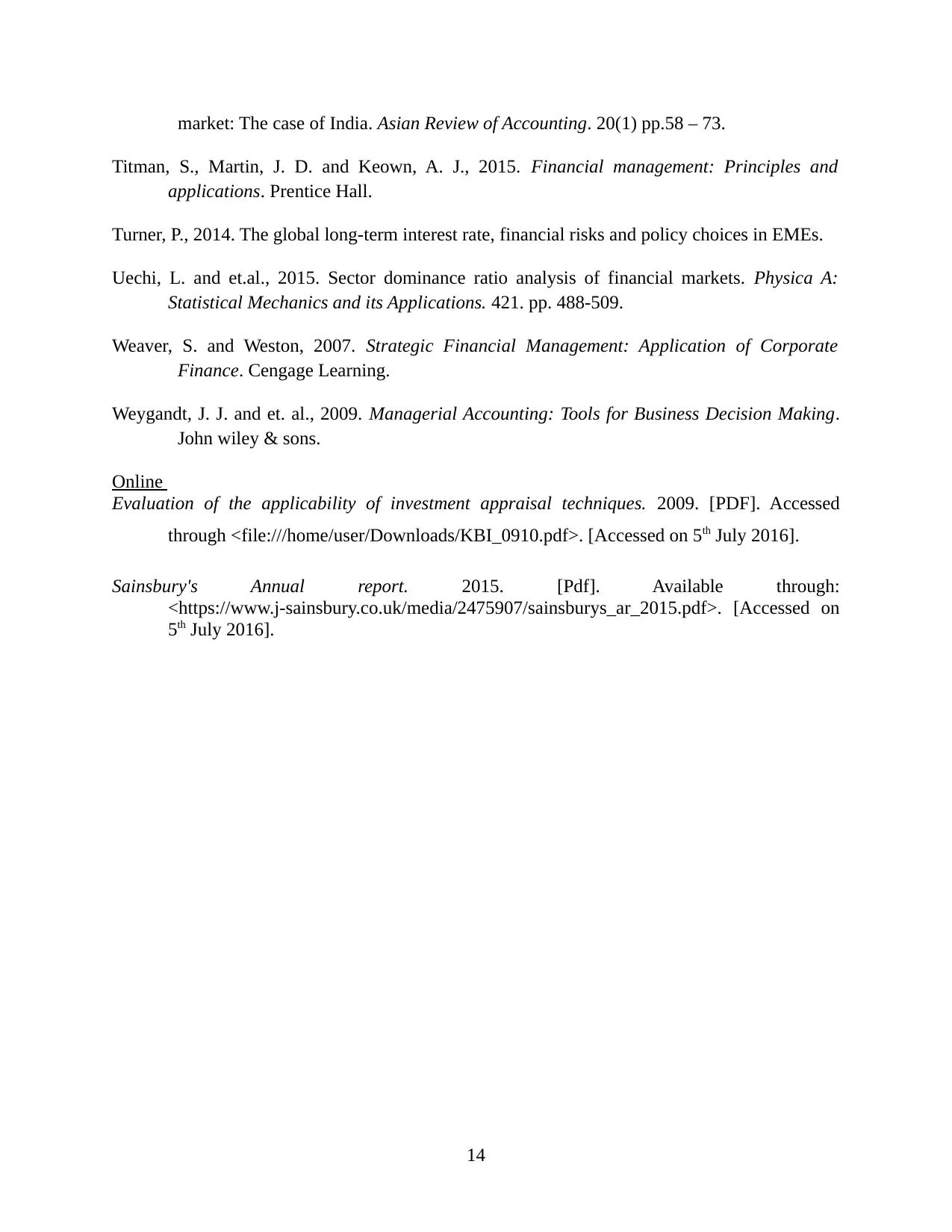
market: The case of India. Asian Review of Accounting. 20(1) pp.58 – 73.
Titman, S., Martin, J. D. and Keown, A. J., 2015. Financial management: Principles and
applications. Prentice Hall.
Turner, P., 2014. The global long-term interest rate, financial risks and policy choices in EMEs.
Uechi, L. and et.al., 2015. Sector dominance ratio analysis of financial markets. Physica A:
Statistical Mechanics and its Applications. 421. pp. 488-509.
Weaver, S. and Weston, 2007. Strategic Financial Management: Application of Corporate
Finance. Cengage Learning.
Weygandt, J. J. and et. al., 2009. Managerial Accounting: Tools for Business Decision Making.
John wiley & sons.
Online
Evaluation of the applicability of investment appraisal techniques. 2009. [PDF]. Accessed
through <file:///home/user/Downloads/KBI_0910.pdf>. [Accessed on 5th July 2016].
Sainsbury's Annual report. 2015. [Pdf]. Available through:
<https://www.j-sainsbury.co.uk/media/2475907/sainsburys_ar_2015.pdf>. [Accessed on
5th July 2016].
14
Titman, S., Martin, J. D. and Keown, A. J., 2015. Financial management: Principles and
applications. Prentice Hall.
Turner, P., 2014. The global long-term interest rate, financial risks and policy choices in EMEs.
Uechi, L. and et.al., 2015. Sector dominance ratio analysis of financial markets. Physica A:
Statistical Mechanics and its Applications. 421. pp. 488-509.
Weaver, S. and Weston, 2007. Strategic Financial Management: Application of Corporate
Finance. Cengage Learning.
Weygandt, J. J. and et. al., 2009. Managerial Accounting: Tools for Business Decision Making.
John wiley & sons.
Online
Evaluation of the applicability of investment appraisal techniques. 2009. [PDF]. Accessed
through <file:///home/user/Downloads/KBI_0910.pdf>. [Accessed on 5th July 2016].
Sainsbury's Annual report. 2015. [Pdf]. Available through:
<https://www.j-sainsbury.co.uk/media/2475907/sainsburys_ar_2015.pdf>. [Accessed on
5th July 2016].
14
1 out of 17
Related Documents
Your All-in-One AI-Powered Toolkit for Academic Success.
+13062052269
info@desklib.com
Available 24*7 on WhatsApp / Email
![[object Object]](/_next/static/media/star-bottom.7253800d.svg)
Unlock your academic potential
© 2024 | Zucol Services PVT LTD | All rights reserved.





